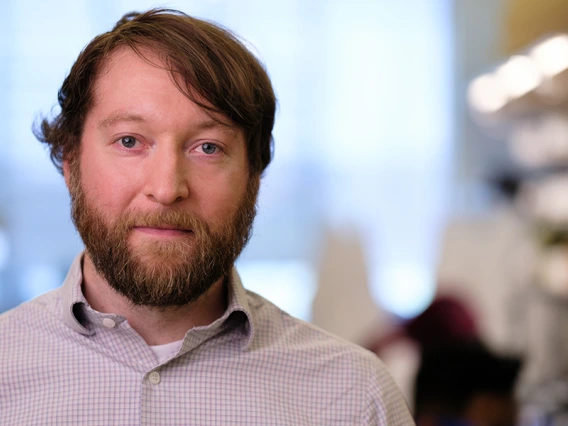40 visionary years for 2025 da Vinci Fellow Pierre Deymier
College of Engineering honors the professor’s remarkable University of Arizona career.

Pierre Deymier accepts the da Vinci Fellowship award from David W. Hahn, the Craig M. Berge Dean.
When Pierre Deymier was a child in Carpentras, France, he loved nothing more than playing in his parents’ hardware store, building and destroying objects with his sister and brother. Then he discovered children’s science kits. He recalls one focused on electricity, one for biology and one for chemistry.
“My brother and I did a lot of experiments with these kits – engineering at the level of kids,” said Deymier, the 2025 College of Engineering da Vinci Fellow and a professor of materials science and engineering. “The kits raised something in my brain that said, ‘You may want to do this for the rest of your life.’”
Following that youthful awakening and completion of a doctoral degree at MIT, Deymier began his career in 1985 at the University of Arizona as a 25-year-old assistant professor.
Forty years later, Deymier’s discoveries have advanced a range of technologies and positioned him among the world’s most prominent scientists. A leading researcher in phononics – a field at the intersection of physics and materials science that explores how sound waves move through materials – Deymier has also made seminal contributions to related applications. His work has raised the university’s status, attracting high-profile grants and awards such as the International Phononics Society’s Bloch Prize.
The College of Engineering selected Deymier for the annual fellowship, which includes a one-time grant of $10,000 made possible by donors to the college's da Vinci Circle.
Acoustic frontiers
Keith Runge has worked with Deymier for two decades and is the knowledge transfer director for the New Frontiers of Sound Science and Technology Center. Deymier became the founding director of NewFoS in 2023, when the National Science Foundation granted the university a $30 million initial investment and the potential to renew after five years with an additional $30 million.
“There are few people in this university, or in this country, who have taken an idea from incipience to fruition with such dedication and success,” Runge said.
In the 17 months since NewFoS launched, Deymier and his colleagues have filed nine invention disclosures and patent applications, a remarkable number, according to Runge.
NewFoS researchers are focused on topological acoustics, a field that examines the measurable landscape sound waves can create in space and explores ways to harness this property. In fact, Deymier and his team are literally writing the book on the subject. The NSF grant stipulates that they create a textbook to teach other researchers and students about the field.
And the center is pursuing its mission on multiple fronts of study. One group is exploring the surprising ways that topological acoustics mirrors quantum particles and the development of phi-bits, acoustic analogs of quantum bits.
“The idea of the phi-bit came from trying to understand how to manipulate sound in ways that mimic quantum behavior, but without the constraints of a quantum system,” said Deymier, who expects to create a phi-bit computer that achieves quantum-level speed and power, in collaboration with other NewFoS researchers.
The phi-bit computer will operate at room temperature. In contrast, a quantum computer requires a maintained temperature of nearly absolute zero to function properly.
NewFoS experts are also focused on three additional primary projects. One group is developing topological acoustic radio frequency wave devices – such as those found in cellphones – that offer longer battery life and more functionality. Another uses topological acoustic sensing as a noninvasive method of evaluation, relying on sound waves to determine material integrity in manufacturing. The final group is using seismic waves to measure changing conditions of the permafrost in Alaska. Like sound waves in air or other media, seismic waves are mechanical vibrations that travel through the Earth.
More acclaim on the horizon
In addition to his work with phononics and topological acoustics, Deymier is recognized for contributions in fields including materials theory, acoustic metamaterials, biomaterials and thermodynamics. In 2024, he was named a fellow-ambassador by France's National Centre for Scientific Research.
Deymier is the author of 228 refereed publications and the editor, author or co-author of three books and six book chapters. He directed the university’s School of Sustainable Engineered Systems from 2009 to 2017 and headed the materials science and engineering department from 2011 to 2021.
His success serves as a powerful example, say his colleagues and the students who learn from him.
“Working firsthand with someone so established and great at what he does is just incredible,” said materials science and engineering doctoral student and NewFoS researcher Howard Yawit.
Yawit believes the NewFoS center, under Deymier’s leadership, will continue to generate findings that advance science and improve an array of products and techniques.
“We have this brand-new, beautiful center,” he said. “Combining that with the knowledge and theory that Dr. Deymier presents will boost understanding of technology as we know it, in ways we’ve never been able to imagine.”


